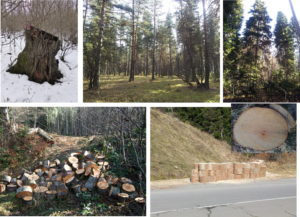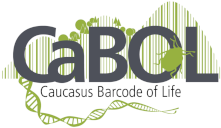Forests and biodiversity in Georgia
The country of Georgia is famous for its biodiversity. According to IUCN (https://www.iucn.org/content/georgia-%E2%80%93-haven-biodiversity ), Georgia is listed number two of the world’s 34 “biodiversity hotspots” and hosts many endemic species. That includes also about 400 tree species. Also, “Georgia is considered to be one of the centers of origin of many domesticated plant and animal species, greatly supporting the agrobiodiversity of the region” (IUCN, ibd.). This alone makes clear that researching into biodiversity and its functions is not only a scientific challenge by itself but has also tremendous practical relevance for mankind. It is the forests that house a large share of terrestrial biodiversity so that a sustainable and smart management of the forests is ‑ not only in Georgia ‑ one important key to protecting and enhancing terrestrial biodiversity. “Sustainable” means, however, that all forest functions are being considered and maintained or enhanced – and that does also include resource-functions like, for example, the production of wood and non-wood forest products. Forests, thus, need to be seen (and managed!) simultaneously as relevant ecosystems and as an important resource. This is the major subject of research in forest sciences.
For Georgia, a forest cover of about 40% is being reported (https://rainforests.mongabay.com/deforestation/2000/Georgia.htm ). However, this figure appears to have been perpetuated since various decades as no changes are being reported since the 1990, and a newer national level forest inventory had not been installed (and is only ongoing as of yet). Also, it is not clear which definition of forest has been used for that figure of about 40% forest cover: traditionally, in Georgia (as in various other countries), all lands of the state-owned forest fund are considered forest; be there trees or not. That is: not a biophysical definition of forest had been used but a cadastral definition.
Georgia is well known both for its very high biodiversity and for heavy pressures on the forest resources from illegal logging and legally guaranteed firewood supply for villagers. The forest area of Georgia thus comprises both beautiful close-to-pristine forests with huge old tree veterans and huge biomasses – and also heavily over-logged and over‑grazed forests, including coppice forests (see Figure 1), with a very low biomass, likely heavily reduced biodiversity, and definitively a very critical regeneration situation.

Figure 1. Above: There are many forest types in Georgia and beautiful forests– but also large areas of heavily degraded forests, in particular in the vicinity of villages where the villagers depend on firewood for heating and cooking. Many forests are left as coppice forests with very low productivity and it is the larger stumps that are testimony to former forests with much larger tree dimensions. Such forests are not only degraded also regarding biodiversity but are also putting into risk the long-term provision of firewood to people. What is required– amongst other measures: a sustainable management of the forests, a more efficient use of firewood, alternative energy sources etc. To start out with a sustainable management, experts and base data are required. The latter include data about the current stock and above all about forest growth as a function of site conditions, species composition and silvicultural treatment –and this is the basic function of the discipline of forest inventory. – Below: fellings are not always systematically planned by experienced foresters but frequently done by villagers for the necessary fuelwood supply (to which they are legally entitled). Then, it also happens that even larger trees with high timber quality sections (very narrow and even year rings) are entirely sliced and go as firewood.
The multi-functionality of Georgian forests is more than obvious: the production function does not only comprise sawn wood and fire wood, but non-timber forest products play a very relevant role as well, including Nordmann fir seed, but also medicinal plants, flowers (Cyclamen sp.), mushrooms, berries, game hunting, and others. And of course, water and soil protection play a role as does tourism and recreation. Research towards conservation and enhancement of biodiversity needs to go far beyond counting the still existing species – but needs to take into account this complex multi-functionality of Georgian forests.
In order to implement sustainable management of Georgian forests, however, two relevant pre-conditions need to be met: (1) solid expertise and (2) solid data. In a Georgian-German Biodiversity Center we wish to contribute to both these targets on all required levels of science, training and implementation.
Regarding the pre-condition “solid data”, comprehensive base information needs to be there on all geographical levels, and that includes national level information that supports the government to devise sustainable policies and regulations to managing the forests, which in turn does also include defining a network of protected forests that are not used for wood production.
Such required base information is generated by forest inventories in the framework of forest monitoring systems. In 2018 and 2019, the first national forest inventory for Georgia is starting to be implemented. The University of Göttingen (the Chair of Forest Inventory and Remote Sensing) has considerably contributed to designing the corresponding national forest monitoring system through consultancies to the Georgian Ministry of Environment and Natural Resources Protection (MONREP) in the framework of a long term technical cooperation between the Governments of Georgia and Germany (GIZ project IBiS “Integrated Biodiversity Management, South Caucasus”).

Figure 2. Training in forest inventory field plot measurements, implemented within the GIZ Project IBiS for staff of the Ministry, students and representatives of Georgian private consulting companies that play a central role as service providers in forest inventory in Georgia.
An important component of this endeavor is training (see Figure 2) and capacity development that combines technical skills of forest mensuration, sampling statistics and remote sensing with strategic skills of information needs and information processing: only with a good understanding of forest monitoring as an integrated system can a comprehensively useful monitoring system be implemented, which provides information on all functions of forests, including biodiversity
The role of Uni. Göttingen, Forest Inventory and Monitoring, in GGBC:
Building on these prior experiences in the field of forest monitoring
The Georgian-German Biodiversity Center will focus on both
- research into the high biodiversity of the largely untouched ecosystems where the focus will be on taking stock and documenting biodiversity on all levels from ecosystem diversity to genetic diversity, by means of modern techniques that include barcoding and remote sensing; and also
- research towards the rehabilitation of degraded ecosystems where human interventions and management options will be at stake so that a strong view will be on people and their needs and livelihoods.
Regarding forests, GGBC thus pursues a holistic view on forest biodiversity covering both basic scientific research and strategic research at the science-policy interface. Forest management as such belongs to focus (2), following the saying “Forestry is not first about trees, it is first about people”.
While academic teaching and research is strong in Georgian universities regarding forest ecosystem research, it appears that the field of forest management is lesser well covered. This has probably also to do with a very low reputation that foresters and the forestry profession enjoy in the country. That sector is not yet sufficiently attractive for smart and well‑qualified university graduates.
GGBC will, therefore, foster academic education in the field of biodiversity management and forest management and of approaches to integrate the two. This teaching will comprise the development of curricular elements, the design of field courses and field labs, the definition and supervision of bachelor and master theses and the facilitation of exchanges of students and staff in both directions.
Conservation and enhancement of terrestrial biodiversity will benefit very much from the introduction of well planned, science-based and sustainable forest management. The Georgian Government is supporting this development, also with support from the German Technical Cooperation. Part of this is the planning and eventually implementation of the first Georgian National Level Inventory Forest in the years to come. This science-based inventory study will soon provide the Georgian Ministry of Environment and Natural Resources Protection (MoENRP) and also the Georgian society with valuable and quality-checked data on the Georgian forests both from an ecosystem and from a resource perspective.
This first Georgian National Level Forest Inventory is planned as a part of a long term National Forest Monitoring System where follow-up inventories will be carried out every 10 years. GGBC will consider to link into this national level study and research into options how to add novel components of biodiversity monitoring, for example through the systematic collection of samples for barcoding.
Such an enhancement of national forest inventories (integrating state-of-the-art genetic monitoring) may serve as a good practice example worldwide for at least two reasons:
- it opens up the possibility to include the assessment of many more taxa than “only” trees by taking samples for barcoding. This is currently a bottleneck in forest monitoring simply because it is impossible (or at least economically inefficient) to integrate the corresponding experts into the forest inventory field work).
- it will improve in general the identification of species, also of tree species: one of the biodiversity-related challenges of forest monitoring in species-rich regions is the observation error regarding tree species which refers mainly to the lesser abundant species and those that are not commercially utilized.
With this line of research, University of Göttingen is contributing to the “macro level” of biodiversity research, directly linking it to people and management of the forests, while the barcoding endeavor covers the “micro level” with a strong basic research focus. The combination of both constitutes one of the particularities and strengths of the concept of GGBC.
Following the century-long tradition of research in forest management it is recommended to install a number of long-term observational and experimental plots of larger size in “typical” ecosystems of Georgia where the development of biodiversity is researched and monitored, possibly also with an experiment that comp ares different management schemes. Such “Biodiversity Observatories / Exploratories” would form an instructive basis not only for biodiversity research but also for academic teaching and for welcoming students for their thesis research and foreign researchers and teams of researchers for implementation of collaborative projects on forests and biodiversity monitoring.
The Georgian-German Biodiversity Center and its planned network with other institutions (universities, forest services, conservation institutions) will be a suitable platform to manage the data coming from these plots on the long run.
Contact:
Christoph Kleinn
Lutz Fehrmann
